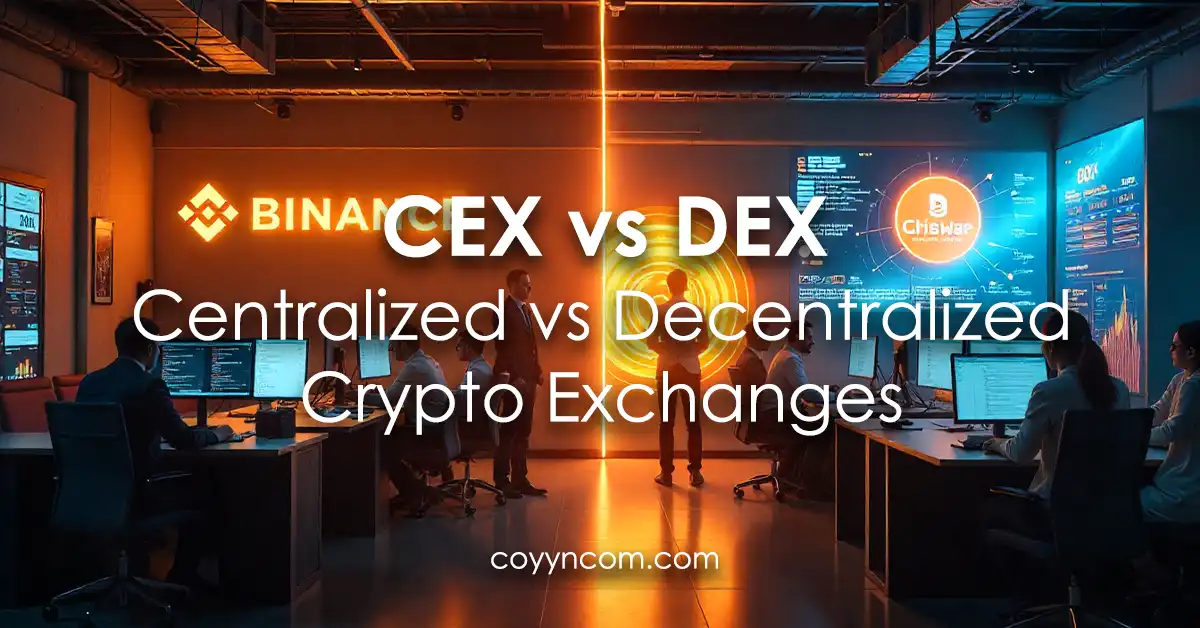In the crypto world, you have a choice between using centralized exchanges (CEX) like Binance or Coinbase and decentralized exchanges (DEX) like Uniswap. These two exchange types differ fundamentally in how they operate, and this core design choice affects almost every part of your trading experience. Simply put, a CEX acts as an intermediary (much like a bank or broker) that holds your funds and matches trades on your behalf, whereas a DEX allows you to trade directly from your own crypto wallet without a middleman. Each approach comes with trade-offs: CEXs are typically more user-friendly and accessible for beginners, while DEXs require more technical know-how but offer greater autonomy and privacy. In this article, we’ll break down what CEXs and DEXs are, compare their key differences, and help you understand which might be best for you – whether you’re a crypto newbie, a seasoned trader, or a financial analyst looking for market insights.
What are Centralized Exchanges (CEX)?
Centralized exchanges are crypto trading platforms operated by a company or organization (a central authority). They function similarly to traditional stock exchanges or brokerages: users sign up for an account (usually completing identity verification/KYC), deposit funds into the exchange’s custody, and the exchange facilitates trades through an internal matching engine. When you use a CEX, you’re entrusting the platform to hold your cryptocurrency and execute your buy/sell orders.
Examples: Popular CEXs include Coinbase, Binance, and Kraken, among others. These platforms are well-known for their ease of use and extensive selection of cryptocurrencies. For instance, Coinbase (a U.S.-based CEX) is often recommended to newcomers for its simple interface and ability to buy crypto with fiat currency (USD/EUR), while Binance (a global CEX) offers a huge range of coins and advanced trading features.
Key Features of CEXs:
- Custodial Platform: When using a CEX, you deposit your crypto or fiat into the exchange’s wallets. The exchange holds your funds and controls the private keys on your behalf. This custody makes trading convenient (you don’t need to manage a blockchain transaction for each trade), but it means you must trust the exchange to secure your assets. (There’s a crypto saying: “Not your keys, not your coins,” highlighting that on a CEX you relinquish direct control of your funds.)
- User-Friendly Experience: Centralized exchanges typically offer intuitive interfaces and tools designed for accessibility. From web dashboards to mobile apps, they often feel like familiar online banking or stock trading apps. You get features like price charts, order books, and one-click buying/selling. Many CEXs also provide customer support and account recovery options, which can be a lifesaver if you forget your password or run into issues. This makes CEXs more accessible for beginners compared to the do-it-yourself nature of DEXs.
- High Liquidity and Fast Trades: Big CEXs aggregate thousands of traders in one place, resulting in deep liquidity pools. This means you can usually execute large orders quickly without moving the market price too much. The exchange’s centralized matching engine can instantly pair buyers and sellers, so transactions are fast and often don’t require waiting for blockchain confirmations. CEXs are ideal for high-volume and high-speed trading – including advanced order types (limit, stop-loss, margin trading, futures, etc.) that many DEXs may lack.
- Fiat Integration: A major advantage of CEXs is support for fiat currencies. You can deposit money from your bank (USD, EUR, etc.) or use a credit card to buy crypto on most centralized exchanges. They serve as an on-ramp for new users who don’t yet have cryptocurrency. (In fact, if you want to start using a DEX but only have cash, you’d likely need to first buy crypto through a CEX.) CEXs handle banking relationships and compliance so that users can seamlessly convert between fiat and crypto.
- Regulation and KYC: Centralized exchanges operate as companies and thus must comply with regulations in the jurisdictions they serve. This often means implementing Know Your Customer (KYC) checks and following anti-money laundering laws. Using a CEX typically requires providing personal identification. While this reduces anonymity, it can enhance security and trust (e.g. if the exchange is licensed or insured). However, regulatory compliance can also limit what assets or services a CEX can offer in certain regions.
Pros of CEX Summarized: CEXs offer convenience, speed, and support. They are easy to use, especially for newcomers, provide high liquidity for large trades, often support fiat purchases, and give access to various trading products all under one roof. If you lose access to your account, the exchange can assist in recovery (since they custody the funds).
Cons of CEX Summarized: On the downside, using a CEX means trusting a third party with your money. There are security risks – large exchanges are attractive targets for hackers, and there have been several high-profile exchange hacks in the past leading to significant losses. You also give up some privacy (due to KYC) and control over your assets. Additionally, CEXs can impose restrictions (withdrawal limits, trading halts) and are subject to outages or regulatory crackdowns, which users have little control over. In extreme cases, a troubled CEX can freeze withdrawals or even go bankrupt, putting user funds at risk (as seen in incidents like Mt. Gox or more recently the FTX collapse).
What are Decentralized Exchanges (DEX)?
Decentralized exchanges are peer-to-peer trading platforms that operate without a central intermediary. Instead of a company holding funds and matching orders, a DEX uses smart contracts on a blockchain to enable users to swap assets directly with one another. In practice, this typically means when you trade on a DEX, you connect your personal crypto wallet (such as MetaMask) to the DEX application, and when you execute a trade, you’re trading straight from your wallet to a smart contract or to another user’s wallet – no custodial exchange in the middle.
Examples: Notable DEXs include Uniswap (a leading Ethereum-based DEX), PancakeSwap (Binance Smart Chain/BSC), SushiSwap, and others. Uniswap, for example, pioneered the Automated Market Maker model for exchanging ERC-20 tokens on Ethereum without an order book. These platforms typically specialize in particular blockchain ecosystems (e.g., Uniswap for Ethereum tokens, PancakeSwap for BSC tokens), though cross-chain DEX aggregators are emerging to connect liquidity across networks.
Key Features of DEXs:
- Non-Custodial & User Control: Perhaps the biggest draw of DEXs is that you retain control of your funds at all times during trading. There’s no need to deposit into an exchange; your crypto stays in your personal wallet until it’s swapped in a trade, and the trade is executed by a smart contract. This means no centralized entity can freeze or access your assets – you are self-sovereign. It also means you bear full responsibility: if you lose your wallet keys or send funds to the wrong address, there’s no customer service to call – those funds could be gone forever.
- Anonymity and Privacy: Decentralized exchanges typically do not require creating an account or providing personal information. You can visit a DEX website/app and start trading by connecting your wallet, with no KYC process at all. Trades are pseudonymous (tied only to your blockchain address). This offers a high degree of privacy and anonymity for users. For privacy-conscious traders or those in locations with restrictive regulations, this is a significant benefit. (Keep in mind, all transactions on public blockchains are still transparent, just not linked to your identity directly; anyone can see the wallet addresses and amounts involved in DEX trades on-chain.)
- Wide Range of Tokens: DEXs often list a much broader array of tokens, including newly launched or niche project tokens that haven’t met the listing requirements of big CEXs. Essentially, if a token exists on the blockchain, it can potentially be traded on a DEX (as long as someone supplies liquidity for it). This open listing model means access to many small-cap or emerging cryptocurrencies. However, it also means less due diligence – there’s a higher risk of encountering scam tokens or low-liquidity assets on DEXs, since there’s no central authority vetting the listings.
- Powered by Smart Contracts (AMMs): Most modern DEXs use an Automated Market Maker model. Instead of matching a buyer with a seller via an order book, liquidity pools are created for token pairs. Users called liquidity providers deposit tokens into the pool, and the smart contract uses a formula to quote prices and facilitate swaps from the pool. This design has pros and cons: it enables continuous liquidity for trades (you can always trade against the pool), but if liquidity is low, large trades will cause significant price slippage. Some newer DEXs and aggregators also offer order book style trading or leverage cross-chain bridges for broader functionality, but the AMM model (pioneered by Uniswap) remains very common.
- No Central Point of Failure: Because there’s no single company or server in control, it’s much harder for a DEX to be shut down by an attack or regulation. The backend is distributed across blockchain nodes. There is also no single honeypot for hackers – funds are in many users’ wallets rather than pooled in one exchange vault. That said, DEXs are not risk-free: the smart contracts themselves could have bugs or vulnerabilities that attackers exploit, sometimes resulting in loss of funds from liquidity pools. So while DEXs eliminate the risk of a company being hacked or misusing funds, they introduce smart contract risk and, for liquidity providers, issues like impermanent loss.
- Technical Complexity: Using DEXs can be more technically demanding. Users must manage a blockchain wallet (keeping track of their private keys or seed phrase), know how to navigate Ethereum or other chains (e.g., having ETH for gas fees), and interact with smart contract interfaces. The process involves steps that might be unfamiliar to a newcomer – for example, setting the right gas price, understanding transaction confirmation times, or manually adding custom token contract addresses. This means DEXs have a steeper learning curve and are less intuitive for non-technical users. There’s usually no customer support or live help either, since it’s just you and the code. As a result, DEXs tend to be favored by more experienced crypto users, while many beginners start on CEXs for simplicity.
Pros of DEX Summarized: DEXs offer greater privacy and control – you trade directly from your wallet with no middleman, preserving anonymity. They provide access to a vast range of tokens (including early-stage projects) and have transparent operations (all activity is on the public blockchain, creating trust through code rather than through a company’s reputation). There are often lower explicit fees (no exchange taker fees; you typically just pay blockchain transaction fees and a small protocol fee) – in favorable conditions this can be cost-efficient. DEXs also sidestep issues of centralized failure or censorship; for example, no one can freeze your trades or funds, and as long as the blockchain is running, the DEX can function.
Cons of DEX Summarized: The flipside is that DEXs can suffer from lower liquidity and slower trade execution, especially for large orders or less popular tokens (you might face price slippage or have to wait for a transaction to confirm on-chain). They are less user-friendly, requiring more technical steps (managing wallets, paying gas fees, etc.). There is no customer service or safety net if you make a mistake – losing your private key or sending funds incorrectly can be irreversible. Additionally, you generally cannot trade using fiat on pure DEXs (you must already have crypto to start), and you won’t find certain features like direct bank withdrawals, advanced order types, or leverage trading in most basic DEXs. In short, DEXs put the responsibility entirely on the user, which can be daunting, but some consider this a worthwhile trade-off for not having to trust a third party.
Key Differences Between CEX and DEX
Now that we’ve defined each type, let’s compare centralized vs decentralized exchanges head-to-head on the features that matter most:
- Control & Custody: On a CEX, the exchange holds your assets in custody. This is convenient (you don’t worry about wallets), but it also means giving up control – and if the exchange is hacked or mismanages funds, your assets could be at risk. With a DEX, you self-custody your funds; trades happen directly from your wallet, so you remain in control of your crypto at all times. The trade-off is personal responsibility: there’s no intermediary to help if you lose access to your wallet or send funds incorrectly. In short, CEX = third-party custody, DEX = user custody (no middleman).
- Security & Trust: CEXs consolidate large pools of crypto, making them attractive targets for hackers – security breaches at centralized exchanges have led to notorious crypto thefts in the past. Users must trust the exchange’s security measures and honesty. DEXs, by keeping funds spread out in users’ wallets, reduce the risk of a mass breach. However, DEX users face smart contract risks – if the DEX’s code has a flaw, it could be exploited. Overall, CEX security depends on the company’s safeguards (and you trusting them), whereas DEX security depends on the blockchain and code (and you taking precautions like using reputable platforms and secure wallets).
- Ease of Use (User Experience): If you value a simple, plug-and-play experience, CEXs have the edge. They offer beginner-friendly interfaces, straightforward buying/selling, mobile apps, and support. You can often reset a lost password or contact support for help on a CEX. DEXs, in contrast, can be intimidating: using them means handling your own wallet, coping with random-seeming error messages from smart contracts, and navigating a more technical interface. No hand-holding here – DEXs require a bit of technical savvy and willingness to learn. In terms of accessibility: CEXs usually just require an email and KYC to get started, whereas DEXs require you to already understand crypto wallets and have some crypto on hand.
- Liquidity & Trade Execution: Large centralized exchanges usually have high liquidity – a large number of buy and sell orders on their order books – which means you can trade big amounts quickly without drastically affecting the price. Prices on CEXs tend to be more stable and closer to the global market average because of this pooled liquidity. DEX liquidity depends on users supplying funds to liquidity pools; for well-known assets, liquidity can be strong, but for smaller tokens it may be limited. As a result, DEX trades can face slippage (price moving during your trade) or even difficulty finding a counterparty for obscure pairs. Also, trade execution on CEXs is faster – their centralized engines match trades instantly. On a DEX, you have to wait for a blockchain confirmation, which could take seconds to minutes, and during times of network congestion, DEX trading can be much slower.
- Fees & Costs: The fee structures differ. CEXs typically charge a trading fee on each transaction (often a percentage like 0.1%–0.5% per trade, sometimes with discounts if you trade a lot or use the exchange’s token). They may also have fees for withdrawals, etc. DEXs generally don’t charge a traditional exchange fee to trade (aside from a small protocol fee in some cases), but you pay the network’s transaction fee (gas) for executing the trade on the blockchain. Depending on the network, those gas fees can be cheap (pennies) or very expensive (tens of dollars during Ethereum congestion). For small trades on a low-fee network, using a DEX can be extremely cheap; but if you’re trading on Ethereum during peak times, the gas cost might exceed a CEX’s fees for the same trade. Bottom line: CEX fees are predictable but can add up (and withdrawal fees can apply), whereas DEX costs vary with network conditions – sometimes cheaper, sometimes pricier.
- Available Assets: If you stick to major cryptocurrencies, both CEXs and DEXs will serve you well. However, for breadth of offerings, DEXs often have the advantage because they allow any token to be listed as long as there’s liquidity. This means DEXs give you access to many altcoins and new project tokens that a CEX might not list (at least not right away). On the other hand, centralized exchanges often perform due diligence and list coins that meet certain quality or compliance criteria, so their selection, while still broad, is curated. Additionally, only CEXs support trading crypto for fiat or vice versa – DEXs are typically crypto-to-crypto only. If you need to go to cash or use bank funds, a CEX is required (or an intermediary step).
- Transparency: DEX operations are fully transparent – all trades and liquidity pool balances are recorded on the public blockchain for anyone to audit in real time. This means you don’t have to trust the exchange to report volumes or holdings honestly; you can verify it yourself on-chain. CEXs, by contrast, operate internally – trade records are on the exchange’s database, and you rely on the company’s word (or occasional third-party audits) to know they’re solvent or not engaging in dubious practices. Some CEXs have started publishing “proof of reserves” to increase transparency, but in general a CEX is less transparent by nature than a DEX.
- Regulation & Compliance: Centralized exchanges usually comply with financial regulations: they often require KYC, may restrict access in certain regions, and follow laws about which assets can be traded. This can provide a level of oversight and protection (for example, a regulated CEX might have insurance against hacks, or be required to hold user funds in certain secure ways), but it also means less privacy and freedom for the user. Decentralized exchanges, being smart contract protocols, generally do not impose KYC or account bans, which gives users more freedom to trade anything, anywhere – at their own risk. Regulators have voiced concerns that DEXs can be used for illicit activity since there’s no identity checking, and the regulatory environment for DEXs is still evolving. For users, the key point is: using a DEX offers more anonymity and access, whereas using a CEX comes with rules you have to follow (but also some recourse if things go wrong).
- Speed & Performance: If you’re a high-frequency trader or someone who values speed, note that CEXs execute trades quickly (orders are filled in milliseconds on centralized servers). DEX trades are tied to blockchain transaction speeds, which are much slower – you might wait several seconds or more for a trade to finalize, and only one block of transactions can be processed at a time. Additionally, during peak network usage, DEX users might experience delays. For most casual trading this isn’t a huge issue, but for activities like arbitrage or rapid-fire day trading, the latency on DEXs can be limiting.
- Features & Services: Centralized exchanges tend to offer a suite of additional features: advanced charting tools, various order types (limit, stop, margin trading), futures and derivatives, staking rewards, lending services, etc. Many are evolving into crypto financial supermarkets. DEXs started simpler (spot swaps only), but they are also innovating – we now have decentralized lending platforms, on-chain derivatives, etc., though often these are separate protocols from the core DEX trading. Generally, if you need sophisticated trading options or an all-in-one platform, a major CEX provides that. DEXs usually specialize in one thing (swaps) and do it in a decentralized way. That said, the gap is narrowing as DeFi (decentralized finance) grows.
- Customer Support: With a CEX, if you have an issue (say a withdrawal is stuck, or you accidentally sent funds to the wrong memo), you can reach out to the exchange’s support team for help. User support and protection measures (like two-factor authentication, account alerts, etc.) are part of the CEX experience. On a DEX, there is no centralized support – at best, you might find community forums or Discord channels where users help each other, but there’s no official entity responsible for resolving user problems. This is an important consideration if you value having a safety net.
- Adoption & Trends: CEXs still handle the majority of crypto trading volume and are the entry point for most retail and institutional investors. They’re widely used and generally more familiar to the public. However, DEXs have been growing in popularity at a rapid pace, especially after events that shake trust in centralized entities (e.g. major exchange hacks or collapses). By early 2025, DEXs accounted for over 20% of total crypto trading volume – a historic high, up from roughly 9% at the start of 2024. This surge is driven by increased interest in DeFi and a desire for self-custody amid regulatory crackdowns on CEXs. The trend suggests that while CEXs remain dominant, decentralized trading is becoming a significant part of the ecosystem, and many traders are starting to use both types of exchanges for different needs.
Choosing Between a CEX and a DEX
So, which type of exchange should you use? The answer will depend on your needs, preferences, and comfort level. Here are a few considerations for different scenarios and user profiles:
- If you’re a Beginner: You’ll likely find a CEX like Coinbase or Binance more straightforward. The user-friendly interface, ability to use familiar payment methods (credit card, bank transfer), and availability of customer support make the learning curve much gentler. For a first-time crypto buyer, being able to buy Bitcoin or Ether with dollars in a few clicks is a big plus. DEXs, by contrast, can be overwhelming for a newbie due to the need to manage wallets and understand transaction fees. Starting on a CEX and then exploring DEXs later (once you have some crypto and basic know-how) is a common path. In fact, even die-hard DeFi users often start on a CEX to acquire crypto with fiat before moving funds to a DEX.
- If you prioritize Convenience and Speed: A CEX is generally the better choice. Trades execute almost instantly, and you don’t have to fiddle with blockchain details. Want to set a limit order and walk away? CEXs have you covered with advanced order types and usually faster trade execution than on-chain transactions. Additionally, if you value having a safety net (for example, the comfort that you can recover your account if you lose your password or that someone is there to help if an issue arises), the customer support and account recovery options on CEXs will be important for you.
- If you value Privacy and Autonomy: A DEX might be more appealing. On a DEX like Uniswap, you don’t need to share personal data or documents, and no corporation can track your trading or restrict your access. You also maintain full control of your assets at all times. For users who are concerned about surveillance, censorship, or just don’t like asking permission to trade, DEXs provide a level of freedom that CEXs cannot. As one guide put it, if you care about freedom from big companies and want to manage your own funds, a DEX is the way to go.
- If you need Fiat Access or Easy On/Off Ramps: Stick with a CEX (at least for that part of your activity). Only centralized exchanges will let you convert fiat currency to crypto and vice versa seamlessly. For example, a platform like Coinbase allows you to sell crypto and withdraw USD to your bank account – something a DEX cannot do. Many people use a combination: a CEX for entering or exiting the crypto market (converting to/from cash) and a DEX for trading between crypto assets once they’re on the blockchain.
- If you’re trading Niche or New Tokens: You might lean towards DEXs. Because anyone can list tokens on a DEX, these platforms often have the newest or less common assets. If you’re an early adopter looking to buy into a just-launched DeFi token or a very niche altcoin, you will probably find it on a DEX (long before any centralized exchange might list it). Just exercise caution – the fact that any token can be on a DEX also means there’s less protection against scams or faulty projects.
- If security is your top concern: This one is a bit nuanced. On one hand, if you don’t trust intermediaries at all and want to eliminate the risk of an exchange hack or fraud, holding your own coins and using a DEX ensures you’re not exposed to a single point of failure like a CEX. On the other hand, if you’re worried about making an operational mistake (like losing keys or sending funds wrong), a CEX might feel safer because the platform can sometimes help recover lost access (and some insure against hacks). Advanced users comfortable with self-custody often prefer DEXs to mitigate counterparty risk, whereas less technical users might sleep better knowing a reputable CEX is handling security (e.g., storing coins in cold storage, etc.).
- If you want Advanced Trading Features: Centralized exchanges are still the go-to. For example, if you want to trade with leverage, or short sell, or set stop-loss orders, major CEXs offer derivatives (futures, options) and sophisticated trading tools that pure DEXs generally lack or are only just starting to offer. There are some decentralized derivatives platforms and on-chain margin trading protocols, but they may have lower liquidity or be more complex to use. Traders who need high-speed chart analysis, API trading bots, or integrations with other financial systems often stick with CEXs for these needs.
- Geographical or Legal Considerations: If your country blocks access to certain CEXs or if you cannot fulfill a CEX’s KYC requirements, a DEX can be an alternative since it’s just a blockchain protocol (it generally can’t ban specific users based on location). DEXs are accessible to anyone with an Internet connection and a compatible wallet. However, keep in mind using a DEX doesn’t make you immune to the law – you’re still responsible for complying with any regulations in your region regarding crypto.
- A Balanced Approach – Using Both: In practice, many crypto users utilize both CEXs and DEXs to complement each other. For example, you might buy your main holdings on a trusted CEX (for convenience and reliability) and then transfer some funds to a DEX when you want to trade a smaller cap token or participate in a DeFi yield farm. Using both can also be a way to mitigate risks: you don’t keep all your money on a centralized exchange (avoiding total loss if it were hacked), but you also don’t limit yourself to just decentralized options. As one article noted, there’s nothing stopping you from benefiting from the ease of a CEX and the freedom of a DEX at the same time – it all comes down to what you need for a given situation.
Lastly, be aware of hybrid solutions emerging in the market. Some platforms are attempting to blend the advantages of CEX and DEX, such as non-custodial exchanges with centralized order matching, or CEXs that integrate DeFi liquidity behind the scenes. These are still evolving, but they signal an interesting future where the line between CEX and DEX might blur, giving users the best of both worlds.
Conclusion
There is no one-size-fits-all answer in the CEX vs DEX debate – each has its own strengths and weaknesses, and the “best” choice depends on your priorities. Centralized exchanges offer a smooth, familiar trading experience with lots of features and customer support, which is great for ease of use. Decentralized exchanges offer empowerment through self-custody, privacy, and open access to a world of tokens, aligning with the crypto ethos of decentralization. Many savvy crypto users decide to use CEXs and DEXs in tandem: for example, a CEX for quick trades or cashing out to fiat, and a DEX for exploring new tokens or keeping long-term control of certain assets.
In summary, if you prefer simplicity, speed, and don’t mind trusting a company, a CEX is likely your go-to; if you prioritize control over your funds and privacy, a DEX is worth using. Neither model is inherently “better” – they’re just different, catering to different needs. As the crypto ecosystem matures (and in light of events like exchange hacks or regulatory crackdowns), it’s wise to understand both options. By knowing the differences outlined above, you can make an informed decision about where to trade that best fits your comfort level and goals. Happy trading, and remember – always do your own research and consider spreading your risk rather than putting all your eggs in one basket, whether centralized or decentralized!
Sources: The information in this article is based on a comparison of CEX vs DEX features from multiple reputable sources, including BitPay’s crypto education guide, an NFT Evening analysis of key differences, and insights from Britannica and industry research on adoption trends. These sources highlight how CEXs like Coinbase and Binance are beginner-friendly and liquid, whereas DEXs like Uniswap provide privacy and control – underscoring the trade-offs to consider when choosing your crypto trading platform.
Frequently Asked Questions (FAQs)
1. What is the main difference between a CEX and a DEX?
CEX (Centralized Exchange) is managed by a company that holds user funds and matches trades (e.g., Binance, Coinbase). DEX (Decentralized Exchange) allows users to trade directly from their wallets using smart contracts (e.g., Uniswap).
2. Which is safer to use — CEX or DEX?
Both have risks. CEXs are vulnerable to hacks or mismanagement since they hold your funds. DEXs offer more control and privacy but require users to secure their own wallets and understand smart contracts.
3. Can I use fiat money (USD, EUR) on a DEX?
No, DEXs do not support fiat. You must already own cryptocurrency to use a DEX. For fiat on-ramps, you’ll need to use a CEX like Coinbase or Binance.
4. Are decentralized exchanges legal?
Yes, DEXs are legal to use in most countries. However, they are less regulated, and users are responsible for complying with local laws. Always check your region’s crypto regulations.
5. Which is better for beginners — CEX or DEX?
CEXs are better for beginners due to their user-friendly design, fiat access, and customer support. DEXs are more suited for experienced users who value privacy and control.






